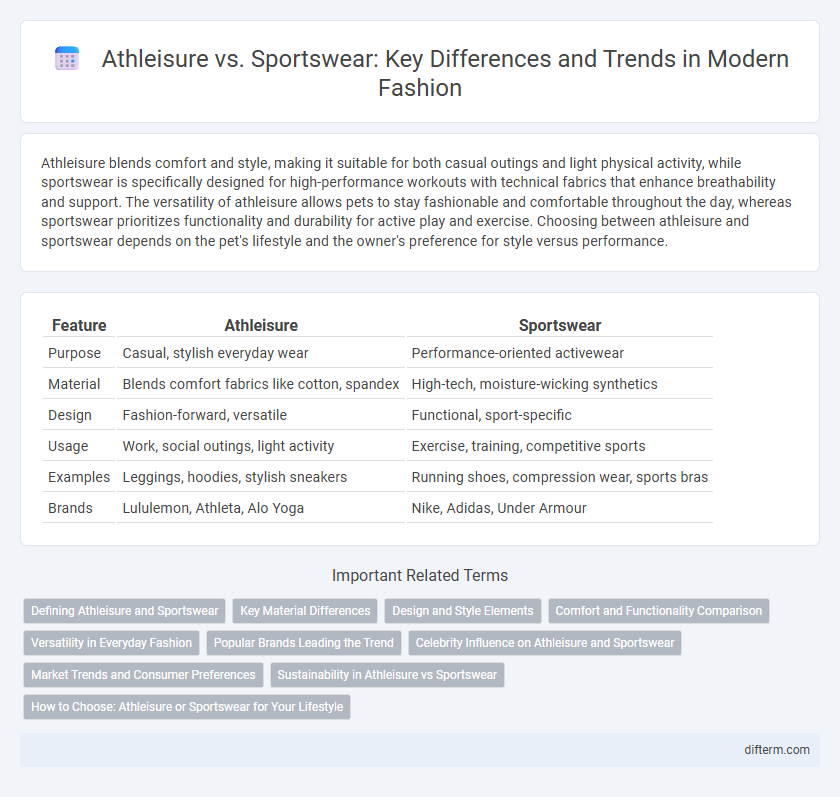Athleisure blends comfort and style, making it suitable for both casual outings and light physical activity, while sportswear is specifically designed for high-performance workouts with technical fabrics that enhance breathability and support. The versatility of athleisure allows pets to stay fashionable and comfortable throughout the day, whereas sportswear prioritizes functionality and durability for active play and exercise. Choosing between athleisure and sportswear depends on the pet's lifestyle and the owner's preference for style versus performance.
Table of Comparison
| Feature | Athleisure | Sportswear |
|---|---|---|
| Purpose | Casual, stylish everyday wear | Performance-oriented activewear |
| Material | Blends comfort fabrics like cotton, spandex | High-tech, moisture-wicking synthetics |
| Design | Fashion-forward, versatile | Functional, sport-specific |
| Usage | Work, social outings, light activity | Exercise, training, competitive sports |
| Examples | Leggings, hoodies, stylish sneakers | Running shoes, compression wear, sports bras |
| Brands | Lululemon, Athleta, Alo Yoga | Nike, Adidas, Under Armour |
Defining Athleisure and Sportswear
Athleisure combines athletic apparel with casual wear, designed for comfort and versatility in everyday settings, blending performance fabrics with style. Sportswear refers specifically to clothing engineered for athletic activities, emphasizing functionality, durability, and moisture-wicking properties to enhance physical performance. The key difference lies in athleisure's dual purpose for both exercise and leisure, while sportswear is optimized solely for sports and training.
Key Material Differences
Athleisure often uses soft, stretchy fabrics like cotton blends and modal for comfort and casual wear, while sportswear incorporates high-performance materials such as moisture-wicking polyester, nylon, and spandex to enhance breathability and durability during intense physical activities. Sportswear focuses on technical features like mesh panels and compression fabrics that optimize sweat management and muscle support, contrasting with athleisure's emphasis on style and everyday wearability. These material differences define the functionality and aesthetic appeal distinct to each category within the fashion industry.
Design and Style Elements
Athleisure merges comfort with fashion by incorporating sleek silhouettes, stretchable fabrics, and versatile color palettes suitable for both casual and active lifestyles. Sportswear focuses on performance-driven design elements such as moisture-wicking materials, reinforced seams, and ergonomic cuts tailored for athletic functionality. The blending of technical innovation with trendy aesthetics distinguishes athleisure from traditional sportswear, making it a staple in contemporary wardrobes.
Comfort and Functionality Comparison
Athleisure offers a versatile blend of comfort and casual style, featuring soft, breathable fabrics designed for all-day wear and seamless transitions from workouts to social settings. Sportswear prioritizes functionality with moisture-wicking, compression technology, and enhanced durability tailored for high-intensity physical activities. Both categories emphasize comfort, but sportswear integrates specialized performance features to optimize athletic performance, while athleisure focuses on relaxed fit and aesthetic appeal.
Versatility in Everyday Fashion
Athleisure seamlessly blends comfort and style, allowing versatile wear from workouts to casual outings, making it a staple in everyday fashion. Unlike traditional sportswear, which is designed primarily for performance and specific athletic activities, athleisure incorporates trendy elements that elevate its appeal beyond the gym. The adaptability of athleisure pieces, such as leggings, joggers, and hoodies, caters to dynamic lifestyles, enhancing both functionality and aesthetic in modern wardrobes.
Popular Brands Leading the Trend
Nike, Adidas, and Lululemon dominate the athleisure market, blending comfort with style to appeal to fashion-conscious consumers. Under Armour and Puma are gaining ground in sportswear by incorporating advanced performance fabrics and innovative designs. These brands drive the trend by merging functionality with everyday wearability, setting new standards in both sectors.
Celebrity Influence on Athleisure and Sportswear
Celebrity endorsements significantly boost the popularity of athleisure by blending high fashion with comfort, influencing mass consumer behavior. Icons like Rihanna and Kanye West have propelled athleisure brands such as Fenty and Yeezy into mainstream culture, driving sales and trends. In contrast, traditional sportswear brands like Nike and Adidas leverage athlete partnerships to reinforce performance and technical innovation, attracting fitness enthusiasts and professional athletes.
Market Trends and Consumer Preferences
Athleisure market growth outpaces traditional sportswear, driven by consumer demand for versatile clothing that transitions seamlessly from workouts to casual settings. Data reveals a rising preference for multifunctional fabrics offering comfort, breathability, and style, reflecting lifestyle shifts toward health and wellness. Brands investing in innovative designs and sustainable materials capture significant market share amid evolving consumer values.
Sustainability in Athleisure vs Sportswear
Athleisure brands increasingly prioritize sustainability by incorporating recycled fabrics and eco-friendly dyeing techniques, reducing their environmental footprint compared to traditional sportswear lines. Sportswear companies are gradually adopting sustainable innovations, but athleisure's casual, everyday use drives higher demand for durable, regenerative materials. Consumer preference for ethical production and transparency boosts sustainable athleisure growth, setting new industry standards for low-impact activewear.
How to Choose: Athleisure or Sportswear for Your Lifestyle
Athleisure offers versatile, stylish comfort suitable for casual outings and light physical activities, blending fashion with functionality, while sportswear is specifically engineered for high-performance workouts, featuring moisture-wicking fabrics and ergonomic designs. To choose between them, assess your primary activities: prioritize athleisure if your lifestyle demands seamless transition between gym and social settings, or opt for sportswear if your routine involves intense training requiring optimized support and durability. Fabric technology, fit, and intended use are key factors in selecting garments that enhance both performance and aesthetic appeal in your daily wardrobe.
Athleisure vs sportswear Infographic

 difterm.com
difterm.com